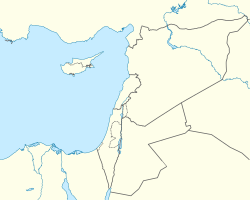Hama
حَمَاة | |
|---|---|
City | |
Clockwise from top: Hama skyline, Norias of Hama, Azem Palace, Al-Hassanein Mosque, Nur al-Din Mosque, Khan Rustem Pasha | |
| Nicknames: | |
| Coordinates: 35°08′N 36°45′E / 35.133°N 36.750°E | |
| Country | |
| Governorate | Hama Governorate |
| District | Hama District |
| Subdistrict | Hama Subdistrict |
| First settled | 1500 BC |
| Government | |
| • Governor | Kamal Abdul Rahman Barmo[2] |
| Elevation | 305 m (1,001 ft) |
| Population (2023 census) | |
| • Total | 996,000[1] |
| • Ethnicities | Syrians |
| • Religions | Sunni Islam Syriac Orthodox Church Greek Orthodox Church |
| Demonym(s) | Arabic: حموي, romanized: Ḥamwi |
| Time zone | UTC+2 (EET) |
| • Summer (DST) | UTC+3 (EEST) |
| Area code(s) | Country code: 963 City code: 33 |
| Geocode | C2987 |
| Climate | BSk |
| Website | www |
Hama (Arabic: حَمَاة Ḥamāh, [ħaˈmaː]; Syriac: ܚܡܳܬ, romanized: ħ(ə)mɑθ, lit. 'fortress'; Biblical Hebrew: חֲמָת, romanized: Ḥămāṯ) is a city on the banks of the Orontes River in west-central Syria. It is located 213 km (132 mi) north of Damascus and 46 kilometres (29 mi) north of Homs. It is the provincial capital of the Hama Governorate. With a population of 996,000 (2023 census), Hama is the fourth-largest city in Syria after Damascus, Aleppo and Homs.[3][4]
The city is renowned for its seventeen norias used for watering the gardens, which are locally claimed to date back to 1100 BC. Though historically used for purpose of irrigation, the norias exist today as an almost entirely aesthetic traditional show.
- ^ "2023 official census". cbss. Retrieved 3 January 2024.
- ^ "الرئيس الأسد يصدر مَراسيم بتعيين محافظين جدد لخمس محافظات" [President Al-Assad issues decrees appointing new governors for five governorates]. SANA. 17 October 2024. Retrieved 17 October 2024.
- ^ Updated: Your Cheat Sheet to the Syrian Conflict. PBS.
- ^ "Hamah (Syria)". Encyclopædia Britannica. Retrieved 3 June 2013.








